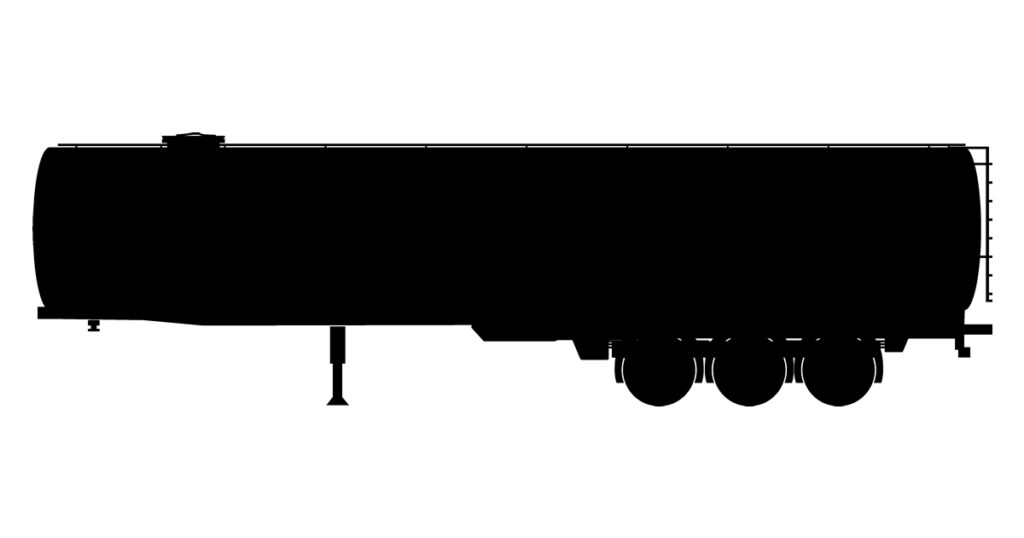Home » Trailers » Semi-Trailer Types » Tank Trailers

Tank Trailers
Tank Trailers (Tanker Trailers) are designed to transport liquids, gases, or dry bulk materials. Tank trailer designs vary depending on the type of freight being transported.
Trailer Characteristics
Common Freight
- Chemicals
- Liquids
- Gases
- Dry bulk product
Dimensions
- Common Lengths: 40′, 42′, 43′, 45′, 48′, 53′
- Overall Width: 96″ – 102″
- Common Heights: 12′ – 13’6″
Capacity
- varies
Types of Tank Trailers
Tank Trailers are commonly categorized as follows.
- Dry Bulk Tank Trailers: Used for the transportation of materials such as sand and fertilizer.
- Chemical Tank Trailers: Used for the transportation of industrial chemicals. Some models can be designed to safely carry corrosive chemicals.
- Food Grade Tank Trailers: Used for the transportation of liquids such as water, milk, and juice. These models may come with a heating and/or cooling system. There are also food grade dry bulk variations that can carry foods such as sugar, salt, and flour.
- Oil Tank Trailers: Used for the transportation of petroleum products and chemicals.
- Corrosives Tank Trailers: Used for the transportation of highly corrosive materials.
- Hot Products Tank Trailers: Used for the transportation of hot liquids, such as asphalt.
- Petro-Chemical Tank Trailers: Used for the transportation of petrochemicals such as benzene, toluene, and xylene.
Tank Trailer DOT Codes
The U.S. Department of Transportation (DOT) has established categories for tank trailers. The following highlights basic characteristics of each category.
DOT 406: Non (low) Pressure Bulk Liquid Cargo Tank
- Pressure: up to 4 psi
- Oval or egg-shaped cross-section
- Flat or nearly flat ends
- Construction: Aluminum
- Usually multi-compartmented
- Separate manhole for each compartment
- Emergency Shutoff: drivers side front
- Rollover protection to prevent manholes from opening up on rollover
- Average Maximum Capacity: 9,000 gallons
- Used to Transport: Petroleum products, water or milk
DOT 407: Low-pressure Bulk Liquid Cargo Tank
- Pressure: up to 40 psi @ 70°F
- Horseshoe-shaped cross-section
- Flat or slightly rounded ends
- Construction: Stainless Steel
- May be insulated
- Manway usually center (top) of tank
- Discharge Valves: usually center (bottom) of tank
- If multi-compartmented, will have a separate manhole for each compartment
- Emergency Shutoff: drivers side front
- Rollover protection to prevent manholes from opening up on rollover, normally center of tank top
- Average Maximum Capacity: 6,000 gallons
- Used to Transport: Mild acids, combustible products
DOT 412: Corrosive Cargo Tank
- Pressure: -5 to 25 psi
- Lined tank
- Round cross section
- Construction: Stainless steel
- May be insulated
- Manway: usually rear (top) of tank
- Discharge Valves: usually rear (bottom) of tank
- If multi-compartmented, will have a separate manhole for each compartment
- Emergency Shutoff: drivers side front
- Average Maximum Capacity: 4,000 – 6,000 gallons
- Used to Transport: Corrosives, high weight liquids
MC-331: Gases that are Liquefied by Pressure Application Only
- Pressure: 100 to 500 psi
- Circular cross section
- Rounded ends
- Construction: Single shell carbon steel
- All valves, gauges, piping protected against damage from rollovers
- Painted white for reflecting suns UV light rays
- Capacity: 2,500 gallons (bobtail) – 11,500 gallons (highway transport truck)
- Used to Transport: Propane (LPG), Butane, Chlorine, Anhydrous Ammonia
MC-338: Cyrogenic Cargo Tank
- Pressure: 23.5 to 500 psi
- Cylindrical shape with “box cabinet” on rear of tank, door for loading/unloading
operations are usually within these doors - Thermos bottle design; 2 cylinders, cylinder-within-a-cylinder
- Area between 2 cylinders evacuated of air (vacuum)
- Used to Transport: Substances which cannot be liquefied by pressure application alone. These
substances must be “super cooled” to become a liquid (liquid oxygen, hydrogen, carbon dioxide)
High-pressure Tube: Gasses that Can Not be Liquefied with Pressure Application
- Pressures: 4,000 – 6,000 psi per tube
- Usually 9 to 12 tubes per trailer
- Each tube is a separated container
- Each tube is thermally protected with thermal plug that is designed to melt out under fire conditions to relieve internal pressure
- Tubes are individually controlled in rear compartment
- Used to Transport: Gases that can not be liquefied by only pressure application (Helium, Nitrogen, Argon)
Dry Bulk: Pneumatically Off-Loaded Hopper Trailer
- Capacity: up to 1,500 cubic feet of dry product
Tank Trailer Manufacturers
- Bedard Tankers
- Brenner
- Bulk Tank Inc (BTI)
- Fruehauf
- Heil Trailer
- ITI Trailers & Truck Bodies
- J&L Tank
- LBT Inc
- LMT
- Mac Trailer
- Paron
- Polar Tank Trailer
- Raglan Industries
- Retesa
- Stainless Tank & Equipment (STE)
- Stephens
- Tremcar
- Vantage Trailers
- Wabash National
- Wolf Tanks
